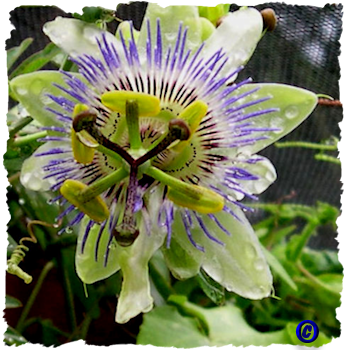 The Blue Crown Passionflower, as passiflora caerulea is commonly called, is not so common at all. Striking pearlescent petals cup a bluish purple crown, and the stamens hang high like a king's crown, perhaps giving rise to that common name in the first place.
The Blue Crown Passionflower, as passiflora caerulea is commonly called, is not so common at all. Striking pearlescent petals cup a bluish purple crown, and the stamens hang high like a king's crown, perhaps giving rise to that common name in the first place.
Bees and butterflies flock to it in droves. Down here in SW Florida, the Gulf fritillary butterfly especially loves it, and often lays her eggs on the larger vines. So one is not only blessed with the fragrant blooms of this passionflower, but also in knowing that keeping the plant helps to give birth to a new generation of these winged jewels.
Some say it is easy to grow. It is a bit tempermental, at least in my little microclimate. It seems to want a sandy but loamy soil, protection from our hot summer dog days, and soil that is slightly dry on the surface, but not too dry.
After the vine becomes established, it is easier to keep it going. I have one that is only two years old, with the main trunk (yes, I will call it that) over 2 inches thick. Ants have moved in the 5 gallon pot it is in, but the passiflora does not seem to mind. Maybe they are helping to create tiny airpockets in the soil, which gives the roots a bit of fresh air. Who knows?
I fertilize the plant about once a month, when I am making up one of the batches for the brugmansia. The rest of the month I just keep it watered regularly, and it has now begun to grow on the roof and other opposing walls of the screenhouse in which it resides. t is even beginning to create dappled sunlight across the roof span, which is perfect for the brugmansia that also reside here. Just today, I tried to lift the pot, and there is no way this will happen. The roots have grown out of the bottom and anchored themselves firmly in the soil beneath it. Oh well, I was only checking, not really planning on moving it.
It has sprouted many children in the two years it has sat there, and I will soon begin to harvest a few and pot them up individually. They will make fine vines for those who purchase them, if they are anything like the mother∼plant.
They were grown by me from seed a couple years back. The seed must have been fresh, as they came up within a month. I did not fertilize them until they had two sets of true leaves, and then at half strength. I advise you to do the same if you are trying your hand at seeds. Too much fertilizer too soon will burn them, and the tender new plants will surely perish.
Protect the adults from frost if you want them to stay green year round. This was my initial purpose for placing them in the screenhouse, as I wanted green year round. The very light (if any) frosts we receive two or three times a year are no threat there, where I can throw down screen siding and cover the roof in less than 10 minutes.
Blue Crown passionflower is fairly hardy, for those of you who'd like to try your hand at growing them farther north, they will live as far up as zone 6. Just mulch the roots heavily before your first frost, and mark the spot so you know where it is come spring. After the snows melt, and spring has sprung, begin to water and fertilize it again, and in no time it will appear and begin to grow like mad. (I know, my mother kept them when I lived up north)
Passiflora do well with a regular fertilizer, the blue granulated one called that, and labelled as MiracleGro does mine well. I get plenty of flowers, and many visits on the outside blue crowns from the bees and butterflies that i love so much.
In zone 10, they will stay evergreen and are great privacy fences. Give them plenty of support, the vines can get huge down here, mine easily spans 30 feet and will keep growing if not cut back. Cutting them back is actually good for them, you will get more blooms this way.
The vine reproduces by sending runners underground. This may or may not bother you. They easily pull up, or you can just keep running over them everytime you mow the lawn. But remember that they spread like this if you plan on placing them in a garden setting. Perhaps you could bury them in a deep, long window box style planter to hinder their spreading habits.
I hope you try your hand at passiflora caerulea, I think you will enjoy the plant as much as me.
Tags: passiflora caerulea, passiflora caerulea, grow passionflower blue crown, blue crown passionflower,

